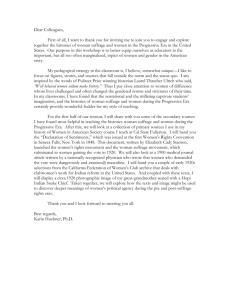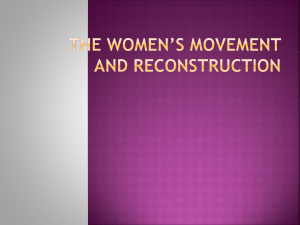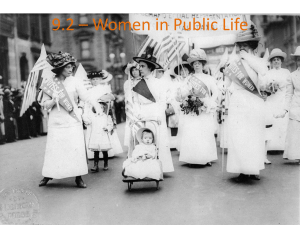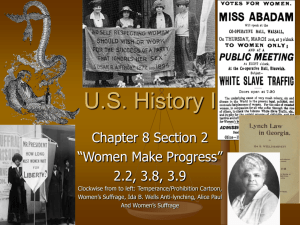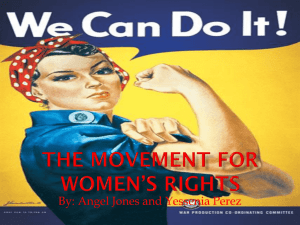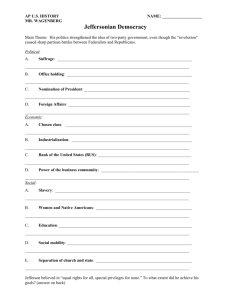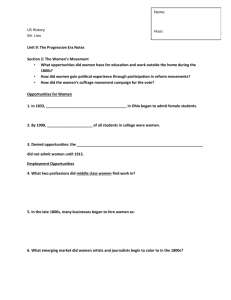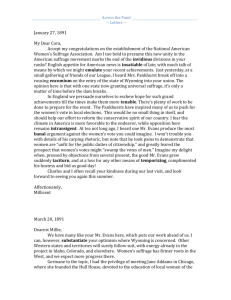Historical Background
advertisement
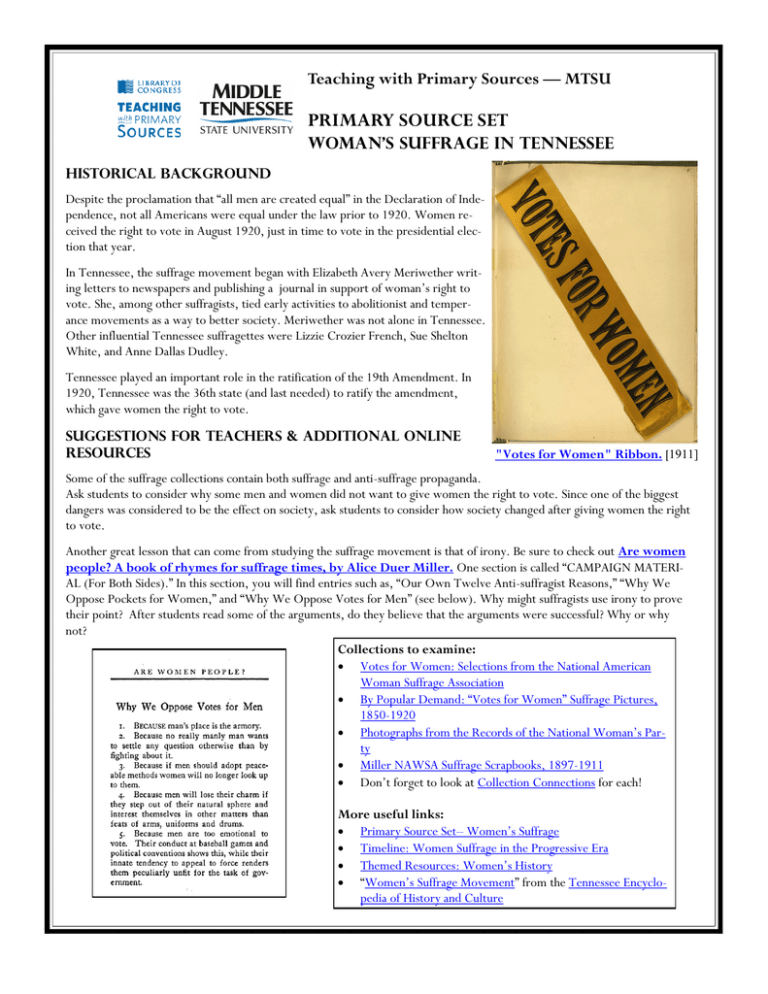
Teaching with Primary Sources — MTSU PRIMARY SOURCE SET Woman’s Suffrage in Tennessee Historical Background Despite the proclamation that “all men are created equal” in the Declaration of Independence, not all Americans were equal under the law prior to 1920. Women received the right to vote in August 1920, just in time to vote in the presidential election that year. In Tennessee, the suffrage movement began with Elizabeth Avery Meriwether writing letters to newspapers and publishing a journal in support of woman’s right to vote. She, among other suffragists, tied early activities to abolitionist and temperance movements as a way to better society. Meriwether was not alone in Tennessee. Other influential Tennessee suffragettes were Lizzie Crozier French, Sue Shelton White, and Anne Dallas Dudley. Tennessee played an important role in the ratification of the 19th Amendment. In 1920, Tennessee was the 36th state (and last needed) to ratify the amendment, which gave women the right to vote. Suggestions for Teachers & additional online resources "Votes for Women" Ribbon. [1911] Some of the suffrage collections contain both suffrage and anti-suffrage propaganda. Ask students to consider why some men and women did not want to give women the right to vote. Since one of the biggest dangers was considered to be the effect on society, ask students to consider how society changed after giving women the right to vote. Another great lesson that can come from studying the suffrage movement is that of irony. Be sure to check out Are women people? A book of rhymes for suffrage times, by Alice Duer Miller. One section is called “CAMPAIGN MATERIAL (For Both Sides).” In this section, you will find entries such as, “Our Own Twelve Anti-suffragist Reasons,” “Why We Oppose Pockets for Women,” and “Why We Oppose Votes for Men” (see below). Why might suffragists use irony to prove their point? After students read some of the arguments, do they believe that the arguments were successful? Why or why not? Collections to examine: Votes for Women: Selections from the National American Woman Suffrage Association By Popular Demand: “Votes for Women” Suffrage Pictures, 1850-1920 Photographs from the Records of the National Woman’s Party Miller NAWSA Suffrage Scrapbooks, 1897-1911 Don’t forget to look at Collection Connections for each! More useful links: Primary Source Set– Women’s Suffrage Timeline: Women Suffrage in the Progressive Era Themed Resources: Women’s History “Women’s Suffrage Movement” from the Tennessee Encyclopedia of History and Culture Are women people? A book of rhymes for suffrage times, by Alice Duer Miller ... [1915] National Woman's Party Headquarters in Nashville, Tenn., in which the campaign for ratification of the suffrage amendment is being conducted, photographed on the day that Parley P. Christensen, presidential nominee for the new Farmer-Labor Party addressed a mass meeting, urging immediate ratification… [1920] Note: See bibliographic page for entire title, which includes a list of those in the picture. Anita Pollitzer, W.J. Jameson, Chairman Nat[ional] Finance Comm[ittee] of Dem[ocratic] Party, checking tally of Tenn[essee]] legislature on ratification. [1920] Enclosure: Fliers supporting women's suffrage Note: This is page 3 of 6. When Tennessee the 36th state ratified, Aug 18, 1920, Alice Paul, National Chairman of the Woman's Party, unfurled the ratification banner from Suffrage headquarters. Shall women vote / by Frank Boylen. [1881] I wonder if it's really becoming? Suffrage Cartoon. Party members picketing the Republican convention, Chicago, June 1920. L-R Abby Scott Baker, Florence Taylor Marsh, Sue White, Elsie Hill, Betty Gram. Citations Teachers: Providing these primary source replicas without source clues may enhance the inquiry experience for students. This list of citations (Chicago Manual of Style) is supplied for reference purposes to you and your students. “’Votes for Women’ Ribbon.” May 6,1911. From the Library of Congress, Miller NAWSA Suffrage Scrapbooks, 1897-1911. http://memory.loc.gov/cgi-bin/query/r?ammem/rbcmillerbib:@field(DOCID+@lit(rbcmiller004024)). Miller, Alice Duer. “Are women people? A book of rhymes for suffrage times, by Alice Duer Miller …” c.1915. From the Library of Congress, Votes for Women: Selections from the National American Woman Suffrage Association Collection, 1848-1921. http:// memory.loc.gov/cgi-bin/query/r?ammem/nawbib:@field(NUMBER+@od1(rbnawsa+n3348)). “Anita Pollitzer, W.J. Jameson, Chairman Nat[ional] Finance Comm[ittee] of Dem[ocratic] Party, checking tally of Tenn[essee]] legislature on ratification.“ 1920. From the Library of Congress, Photographs from the Records of the National Woman's Party. http://memory.loc.gov/cgi-bin/query/r?ammem/mnwp:@field(DOCID+@lit(mnwp000257)). “National Woman's Party Headquarters in Nashville, Tenn., in which the campaign for ratification of the suffrage amendment is being conducted, photographed on the day that Parley P. Christensen, presidential nominee for the new Farmer-Labor Party addressed a mass meeting, urging immediate ratification. Left to right: Rankin Smith, Central Trades and Labor Council; Jim F. Nicholson, Business Manager of the Machinist; W.C. Birthright, Secretary of the Tenn. Federation of Labor; Mrs. Anne Calvert Neely, Mississippi state chairman of the National Woman's Party; W.M. Mitchell; Mrs. Mabel Reber, of New York; Mrs. Walter C. Jackson of Murfreesboro; Mrs. Florence Bayard Hilles, of Wilmington, Delaware, member of the Executive Committee of the Woman's Party; Parley P. Christensen, Presidential candidate of the Farmer-Labor Party; Miss Sue White, of Nashville, Tennessee state chairman of the Woman's Party; W.M. Fox, president of the Trades and Labor Council; Miss Mary Winsor of Philadelphia, Pa., member of the Advisory Council of the Woman's Party; Archie Craig; Charles P. Sweeney.” 1920. From the Library of Congress, Photographs from the Records of the National Woman's Party. http://memory.loc.gov/cgibin/query/r?ammem/mnwp:@field(DOCID+@lit(mnwp000311)). Women’s Suffrage Party. “Enclosure: Fliers supporting women's suffrage.” n.d. From the Library of Congress, Miller NAWSA Suffrage Scrapbooks, 1897-1911. http://memory.loc.gov/cgi-bin/query/r?ammem/rbcmillerbib:@field(DOCID+@lit (rbcmiller004037)). “When Tennessee the 36th state ratified, Aug 18, 1920, Alice Paul, National Chairman of the Woman's Party, unfurled the ratification banner from Suffrage headquarters.” From the Library of Congress, Photographs from the Records of the National Woman's Party. http://memory.loc.gov/cgi-bin/query/r?ammem/mnwp:@field(DOCID+@lit(mnwp000256)). Boylen, Frank. “Shall women vote / by Frank Boylen.” 1881. From the Library of Congress, Music for the Nation: American Sheet Music. http://memory.loc.gov/cgi-bin/query/r?ammem/mussm:@field(NUMBER+@band(sm1881+10757)). New York Press. “I wonder if it's really becoming? Suffrage Cartoon.” n.d. From the Library of Congress, Miller NAWSA Suffrage Scrapbooks, 1897-1911. http://memory.loc.gov/cgi-bin/query/r?ammem/rbcmillerbib:@field(DOCID+@lit (rbcmiller001148)). “Party members picketing the Republican convention, Chicago, June 1920. L-R Abby Scott Baker, Florence Taylor Marsh, Sue White, Elsie Hill, Betty Gram.” 1920. From the Library of Congress, Photographs from the Records of the National Woman's Party. http://memory.loc.gov/cgi-bin/query/r?ammem/mnwp:@field(DOCID+@lit(mnwp000306)).
